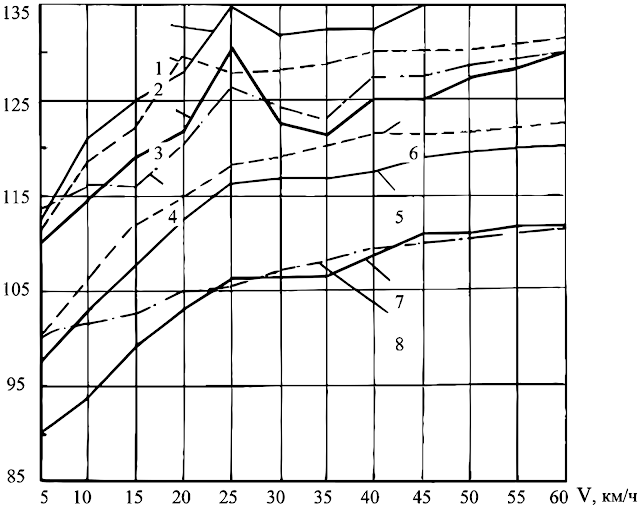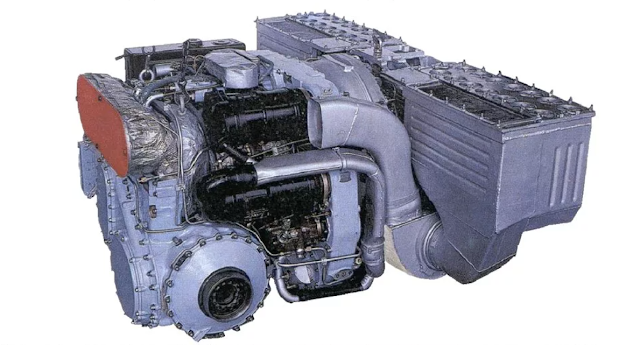Comparative analysis of noise characteristics inside of tanks
This is an introduction to noise characteristics of Soviet/Russian armoured fighting vehicles.
Unspecified variants of T-64, T-72 and T-80 and a T-80UD were chosen. The charts below show the dB/dBA levels for the different crew positions relative to the speed at which the tanks are moving. Tests were carried out on a concrete track. Lines 1-4 indicate LSP values for T-64/T-72/T-80 and T-80UD, while lines 5-8 indicate LS values for the same tanks.
 |
| Chart 1 - Driver's position noise characteristics. (X-axis is used for dB/dBA values) Lines 1-4 LSP values; Lines 5-8 US values for T-64/T-72/T-80 and T-80UD |
 |
| Chart 2 - Turret noise characteristics. (X-axis is used for dB/dBA values) Lines 1-4 LSP values; Lines 5-8 US values for T-64/T-72/T-80 and T-80UD |
Table 1: Level of sound pressure and level of sound inside of driver's position
| Operation mode | LSP (Level of sound pressure), dB | LS (Level of sound), dBA | |||||||
| T-64 | T-72 | T-80 | T-80UD | T-64 | T-72 | T-80 | T-80UD | ||
| Stationary | 112 | 114 | 103 | * | 104 | 102 | 90 | * | |
| V = 5km/h | 112 | 111 | 114 | 110 | 97 | 101 | 92 | 100 | |
| V = 30km/h | 131 | 127 | 124 | 124 | 118 | 119 | 108 | 107 | |
| V = 60km/h | 135 | 132 | 130 | 130 | 120 | 123 | 113 | 113 | |
Table 2: Level of sound pressure and level of sound inside of turret basket
| Operation mode | LSP (Level of sound pressure), dB | LS (Level of sound), dBA | |||||||
| T-64 | T-72 | T-80 | T-80UD | T-64 | T-72 | T-80 | T-80UD | ||
| Stationary | 103 | 110 | 108 | * | 97 | 104 | 90 | * | |
| V = 5km/h | 113 | 108 | 109 | 107 | 93 | 99 | 90 | 97 | |
| V = 30km/h | 127 | 123 | 122 | 123 | 112 | 111 | 106 | 102 | |
| V = 60km/h | 131 | 128 | 129 | 128 | 114 | 116 | 108 | 108 | |
As the speed of the tank changes, the LSP and LS patterns change smoothly, with individual emissions fluctuating due to resonance phenomena. The rate of increase varies from 1.2 to 0.8 dB (5-25 km/h) and from 0.8 to 0.25 dB (25km/h-40km/h).
It can be observed that the LSP and LS values for the driver's position are significantly higher
- Turret basket - T-80 P (102-108), T-80 (104-112), T-64 (111-114), T-72 (112-116)
- Driver's position - T-80 P (105-113), T-80 (105-116), T-64 (117-120), T-72 (118-123)
AFVs are checked for compliance
- Closed hatches, stationary position with the engine operating at medium RPMs.
- Closed hatches, stationary position with the engine operating at maximum RPMs.
- Closed hatches, stationary position with the engine operating at maximum RPMs along with all internal modules turned on.
- Closed hatches, all modules operating based on the recommended mode of operation, engine turned off.
- Closed hatches, all modules operating based on the recommended mode of operation, engine operating at maximum RPMs.
References:
- Google Drive Excel Table 1
- Г. С. Жартовский, Д. В. Куртц, О. А. Усов. Защита оборудования и экипажа военных гусеничных машин от механоакустических и климатических воздействий: Монография. СПб.: Издательство "Лань", 2016.



Comments
Post a Comment